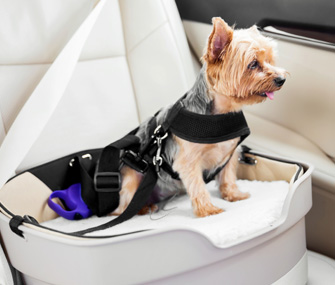Expert Tips for Traveling With Your Dog
Published on July 17, 2014
Skip To

But traveling with your canine can also create stress for you and your dog. Fortunately, proper planning and appropriate expectations can help you manage anxiety. Here are some things to keep in mind when you and your dog travel by train, plane or automobile.
Get Organized
First things first: ID your dog. As a general rule, you should keep your dog’s microchip up to date and make sure your pup has his collar and ID tags on at all times. When you leave home, it’s also a good idea to carry your dog’s medical records, in case he needs to visit a vet while on the road. Amy Burkert of gopetfriendly.com suggests scanning your pet’s important papers and saving them on a flash drive, which is small, compact and easy to access.Plan, plan — and plan some more. According to a recent survey of pet travelers on gopetfriendly.com, one of the more challenging things people traveling with dogs encounter is finding pet-friendly hotels, things to do and places to eat. The solution: Map out your route and do your research ahead of time to be certain that you and your pooch have someplace to stay and aren’t left out of the fun when you get to your destination.
Pack like a pro. “Make a pretravel list,” advises Nikki Moustaki, an author and dog trainer who logs a lot of miles with her three dogs between her residences in New York City and Miami Beach. Moustaki keeps a dog travel bag packed and ready. “That way, all I have to do is grab it, add a couple of things, and go,” she says. Burkert also keeps a “doggie go-bag” with the essentials and recommends including a list of last-minute things your dog might need, like medications or a favorite toy. “It’s not just novices who forget stuff,” Burkert says. “We all do!”
Travel Safely
Secure your dog while you’re on the road — or in the air or on the train. If you and your dog will be flying or traveling by train, research and adhere to airline or railway guidelines about crates or harnesses. When traveling by car, your dog should be secured in either a safety harness or a properly attached crate. Moustaki also advises against removing your dog’s leash when you’re in the car. In the event of an accident, a dog on a leash is much easier for an emergency crew member to grab once he’s out of his harness or crate. “Dogs have been known to bolt from accident sites,” she explains.Keep your dog hydrated. It’s always important to keep your dog well hydrated, but when you’re on the road, you’ll need to make an extra effort to quench your pup’s thirst. Moustaki shares her favorite on-the-go water strategy: “I fill up a nonspill bowl with ice and let it melt. This helps a lot when the weather is hot.”
Reinforce training on the road. Traveling offers a terrific opportunity for your dog to practice using his manners, dog trainer Mikkel Becker says. “The open road creates real-life training scenarios that can constantly be practiced, such as meeting a new person without jumping or learning not to pull on the leash even in intensely excitable situations, like when walking through a crowd or toward another dog,” she explains. However, Becker cautions, the extreme exposure to unfamiliar people and new situations that comes with traveling may intensify stress in undersocialized and anxious dogs, and may exacerbate unwanted reactions. Proceed with caution, just as you would at home, when putting your dog into new situations.
Be Consistent and Polite
Be a considerate traveler — and pet owner. Traveling isn’t just about you and your dog. Burkert advises practicing good canine ownership when traveling with your dog. Be respectful of pet policies and aware of those around you, so you can be a good ambassador for people traveling with pets. Moustaki also suggests that you bathe your dog or have him groomed before you embark on your journey. “For your sake and the sake of others, you want to travel with a clean dog!”Maintain your routine on the road. Traveling can be unpredictable, but try to stick to a routine as much as possible, Burkert says. This means taking walks at the same times as when you’re at home, feeding your dogs on a regular schedule and following the schedule you typically keep while you’re at home, such as snacks at certain times or snuggle time at night.
Be prepared to leave your dog alone. Sometimes, despite your best efforts to find dog-friendly activities and places to go, you may have to leave your dog alone for a while. Becker says it’s important for your dog to be able to be crated or left unsupervised for a brief time if needed. Becker advises that you train your dog to remain relaxed when alone in an unfamiliar hotel room or — ideally — in his crate. For many dogs, Becker explains, “The crate… becomes their personal den area of safety.” In fact, she adds, a crate is really just a “portable comfort zone” for your dog. If your dog dislikes the crate (or if you’re opposed to crating), Becker recommends that you teach your dog to relax in a specific area, like on a mat or bed. That spot can be used to create a safe haven for your dog in any new place.
Whether you’re taking a quick weekend jaunt or a six-week excursion, keep safety and comfort top of mind for both you and your pet and you’ll have a great time making travel memories with your best buddy.
More on Vetstreet.com:





